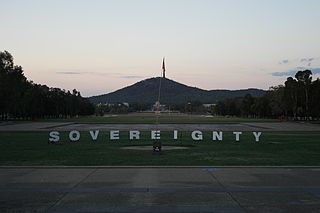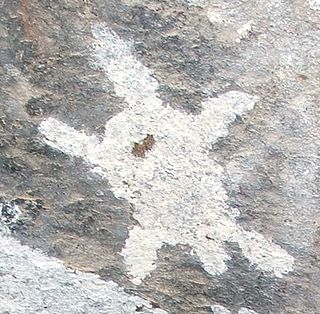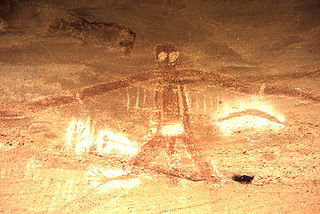
Australian Aboriginal sovereignty is both a concept and a political movement in the 20th and 21st centuries, seeking varying levels of recognition of ownership and/or control of parts of Australia by Aboriginal and Torres Strait Islander peoples. Aboriginal sovereignty is not recognised in the Australian Constitution or Australian law, and calls have been made for constitutional amendments both recognise First Nations sovereignty of the land and to provide an Indigenous voice to parliament. The recognition of prior occupation and ownership of Australia means accepting sovereignty by the First Peoples, and also paves the way for a treaty between the First Peoples and the Government of Australia.

Nimbin is a village in the Northern Rivers area of the Australian state of New South Wales, approximately 30 km (19 mi) north of Lismore, 33 km (21 mi) northeast of Kyogle, and 70 km (43 mi) west of Byron Bay.

Indigenous music of Australia includes the music of Aboriginal and Torres Strait Islander peoples of Australia, intersecting with their cultural and ceremonial observances, through the millennia of their individual and collective histories to the present day. The traditional forms include many aspects of performance and musical instrumentation which are unique to particular regions or Aboriginal Australian groups; there are equally elements of musical tradition which are common or widespread through much of the Australian continent, and even beyond. The culture of the Torres Strait Islanders is related to that of adjacent parts of New Guinea and so their music is also related. Music is a vital part of Indigenous Australians' cultural maintenance.
The Nimbin Aquarius Festival was a counter-cultural arts and music festival organised by the Australian Union of Students. It was the fourth in a biannual series of festivals, first organised by the National Union of Australian University Students (NUAUS). The First Australian Universities Arts Festival was held in Sydney in 1967, and the Second Australian Universities Arts Festival was held in Melbourne in 1969. The third added "Aquarius" to its name and was held in Canberra in 1971. The fourth and last was held in Nimbin, New South Wales in 1973.
Australian Aboriginal English (AAE) is a dialect of Australian English used by a large section of the Indigenous Australian population. It is made up of a number of varieties which developed differently in different parts of Australia. These varieties are generally said to fit along a continuum ranging from light forms, close to Standard Australian English, to heavy forms, closer to Kriol. There are generally distinctive features of accent, grammar, words and meanings, as well as language use. AAE is not to be confused with Kriol, which is a separate language from English spoken by over 30,000 people in Australia. Speakers have been noted to tend to change between different forms of AAE depending on whom they are speaking to, e.g. striving to speak more like Australian English when speaking to a non-Indigenous English-speaking person.

The Ngunnawal are an indigenous Australian people of southern New South Wales and the Australian Capital Territory.
The Garma Festival of Traditional Cultures (Garma) is Australia’s largest Indigenous cultural gathering, taking place over four days each August in northeast Arnhem Land, in the Northern Territory, Australia. Hosted by the Yothu Yindi Foundation, Garma is a celebration of the cultural traditions of the Yolngu people, and a major community gathering for the clans and families of the Arnhem Land region. The event showcases traditional miny'tji (art), ancient story-telling, manikay (song), and bunggul (dance). It is held at Gulkula, a significant Gumatj ceremonial site about 40 kilometres (25 mi) from the township of Nhulunbuy, attracts more than 2500 guests each year and is often sold out months in advance.
Dr Richard Barry Walley OAM is a Nyungar man, one of Australia's leading Aboriginal performers, musicians and writers, who has been a campaigner for the Indigenous cause. He is known for originating the modern Australian welcome to country ritual.
Indigenous Australian self-determination, also known as Aboriginal self-determination, is the power relating to self-governance by Aboriginal and Torres Strait Islander peoples in Australia. It is the right of Aboriginal and Torres Strait Islander peoples to determine their own political status and pursue their own economic, social and cultural interests. Self-determination asserts that Aboriginal and Torres Strait Islander peoples should direct and implement Aboriginal and Torres Strait Islander policy formulation and provision of services. Self-determination encompasses both Aboriginal land rights and self-governance, and may also be supported by a treaty between a government and an Indigenous group in Australia.
Australian Aboriginal culture includes a number of practices and ceremonies centered on a belief in the Dreamtime and other mythology. Reverence and respect for the land and oral traditions are emphasised. Language and other groupings exhibit a range of individual cultures. Australian Aboriginal art has existed for thousands of years and ranges from ancient rock art to modern watercolour landscapes. Aboriginal music has developed a number of unique instruments. Contemporary Australian Aboriginal music spans many genres. Aboriginal peoples did not develop a system of writing before colonisation, but there was a huge variety of languages, including sign languages.

An Australian Aboriginal sacred site is a place deemed significant and meaningful by Aboriginal Australians based on their beliefs. It may include any feature in the landscape, and in coastal areas, these may lie underwater. The site's status is derived from an association with some aspect of social and cultural tradition, which is related to ancestral beings, collectively known as Dreamtime, who created both physical and social aspects of the world. The site may have its access restricted based on gender, clan or other Aboriginal grouping, or other factors.
In Australian Aboriginal art, a Dreaming is a totemistic design or artwork, which can be owned by a tribal group or individual. This usage of Stanner's term was popularised by Geoffrey Bardon in the context of the Papunya Tula artist collective he established in the 1970s.
Ngambri is an Aboriginal name for a locality in the south-east of Australia, near the centre of what is now Australia's capital city of Canberra. The area is close to Black Mountain along Sullivans Creek down to the Yeelamgigee, now Molonglo River. The extent of recognised Ngambri territory, and of their distinction from the Walgalu, has been the subject of controversy in recent years. Canberra, where Ngambri claims are made, lay close to the tribal boundaries that separated the Ngarigo from the Ngunawal.
The repatriation and reburial of human remains is a current issue in archaeology, centering on ethical issues and cultural sensitivities regarding human remains of long-deceased ancestors which have ended up in museums and other institutions. Historical trauma as a result of colonialism is often involved. Various indigenous peoples around the world, such as Native Americans and Indigenous Australians, have requested that human remains from their respective communities be repatriated to their local areas and burial sites from various institutions, often in other countries, for reburial.
Matilda Williams House was born in 1945 on the Erambie Aboriginal Reserve at Cowra, New South Wales (NSW), and raised in her grandfather’s house at Hollywood Aboriginal Reserve in Yass, NSW. When she was 12, House spent a year in Parramatta Girls' Home. House was one of ten children.

Barunga, formerly known as Beswick Creek and then Bamyili, is a small Aboriginal community located approximately 80 kilometres (50 mi) southeast of Katherine, in the Northern Territory of Australia. It is part of the Roper Gulf Region local government area. At the 2011 census, Barunga had a population of 313.
Shane Mortimer is a Ngambri man with a strong connection to the local Canberra region.
Ancestral domain or ancestral lands refers to the lands, territories and resources of indigenous peoples, particularly in the Asia-Pacific region. The term differs from indigenous land rights, Aboriginal title or Native Title by directly indicating relationship to land based on ancestry, while domain indicates relationships beyond material lands and territories, including spiritual and cultural aspects that may not be acknowledged in land titles and legal doctrine about trading ownership.
The Djerimanga, also known as the Wulna, are an indigenous Australian people of the Northern Territory.

The opening ceremony for the 2018 Commonwealth Games took place on the evening of Wednesday 4 April in the Carrara Stadium, Gold Coast. As mandated by the Commonwealth Games Charter, the proceedings of the ceremony combined the formal opening of the sporting event with an artistic performance to showcase the host nation's culture. The 2018 Games were formally opened by Charles, Prince of Wales. Jack Morton Worldwide was given the contract to produce the opening and closing ceremonies of the 2018 Commonwealth Games. The theme of the opening ceremony was Hello Earth and directed by David Zolkwer.







